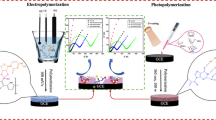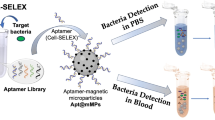Abstract
Molecularly imprinted polymer (HM@MIP) nanoprobes were designed form the pH-responsive polymer (dimethylaminoethyl methacrylate (DMA)) and MIL-101. This probe was applied to the selective determination of hepatitis A virus (HAV) through Resonance light scattering (RLS) technique. DMA adjusts pH of the system to facilitate the capture and release of virus by HM@MIPs as anticipated. And it results in the enhancement or weaken of RLS intensity. According to RLS intensity at 470 nm, a linear concentration of 0.02–2.0 nmol·L−1 and a limit of detection of 0.1 pmol·L−1 were obtained within 20 min. The excellent recoveries ranges from 88% to 107%, and it indicates the prominent ability of the HM@MIPs to determination HAV in human serum and their potential ability to determination virus in real applications.

Principle of preparation of the HM@MIPs and detection of virus.






Similar content being viewed by others
References
Morens DM, Folkers GK, Fauci AS (2004) The challenge of emerging and re-emerging infectious diseases. Nature 430:242–249. https://doi.org/10.1038/nature02759
Ohara PT, Chin MS, Lavail JH (2000) The spread of herpes simplex virus Type 1 from trigeminal neurons to the murine cornea: an Immunoelectron microscopy study. J Virol 74:4776–4786. https://doi.org/10.1128/JVI.74.10.4776-4786.2000
Tahk H, Lee MH, Lee KB, Cheon D-S, Choi C (2011) Development of duplex RT-PCR-ELISA for the simultaneous detection of hepatitis A virus and hepatitis E virus. J Virol Methods 175:137–140. https://doi.org/10.1016/j.jviromet.2011.04.030
Richards GP (1999) Limitations of molecular biological techniques for assessing the virological safety of foods. J Food Prot 62:691–697. https://doi.org/10.4315/0362-028X-62.6.691
Lin L, Fevery J, Yap SH (2002) A novel strand-specific RT-PCR for detection of hepatitis C virus negative-strand RNA (replicative intermediate): evidence of absence or very low level of HCV replication in peripheral blood mononuclear cells. J Virol Methods 100:97–105. https://doi.org/10.1016/s0166-0934(01)00399-8
Catherine C, Vincent M, Laure G, Laurent H, Stanislas P (2011) Acute hepatitis A virus infection without IgM antibodies to hepatitis A virus. Ann Intern Med 154:507–508. https://doi.org/10.7326/0003-4819-154-7-201104050-00017
Shen FC, Su IJ, Wu HC, Hsieh Y-H, Yao W, Young K-C, Chang T-C, Hsieh H-C, Tsai H, Huang W (2009) A pre-S gene chip to detect pre-S deletions in hepatitis B virus large surface antigen as a predictive marker for hepatoma risk in chronic hepatitis B virus carriers. J Biomed Sci 16:1–8. https://doi.org/10.1186/1423-0127-16-84
Chen L, Xu S, Li J (2011) Recent advances in molecular imprinting technology: current status, challenges and highlighted applications. Chem Soc Rev 40:2922–2942. https://doi.org/10.1039/C0CS00084A
Jenik M, Schirhagl R, Schirk C, Hayden O, Lieberzeit P, Blaas D, Paul G, Dickert FL (2009) Sensing picornaviruses using molecular imprinting techniques on a quartz crystal microbalance. Anal Chem 81:5320–5326. https://doi.org/10.1021/ac8019569
Su C, Li Z, Zhang D, Wang Z, Zhou X, Liao L, Xiao X (2020) A highly sensitive sensor based on a computer-designed magnetic molecularly imprinted membrane for the determination of acetaminophen. Biosens Bioelectron 148:11819. https://doi.org/10.1016/j.bios.2019.111819
Shawky SM, Awad AM, Allam W, Alkordi MH, El-Khamisy SF (2017) Gold aggregating gold: a novel nanoparticle biosensor approach for the direct quantification of hepatitis C virus RNA in clinical samples. Biosens Bioelectron 92:349–356. https://doi.org/10.1016/j.bios.2016.11.001
He K, Chen C, Liang C, Liu C, Yang B, Chen X, Cai C (2016) Highly selective recognition and fluorescent detection of JEV via virus-imprinted magnetic silicon microspheres. Sensor Actuat B-Chem 233:607–614. https://doi.org/10.1016/j.snb.2016.04.127
Liu Y, Shen T, Hu L, Gong H, Chen C, Chen X, Cai C (2017) Development of a thermosensitive molecularly imprinted polymer resonance light scattering sensor for rapid and highly selective detection of hepatitis a virus in vitro. Sensor Actuat B-Chem 253:1188–1193. https://doi.org/10.1016/j.snb.2017.07.166
Cumbo A, Lorber B, Corvini PF-X, Meier W, Shahgaldian P (2013) A synthetic nanomaterial for virus recognition produced by surface imprinting. Nat Commun 4:1925–1930. https://doi.org/10.1038/ncomms2529
Bloch ED, Britt D, Lee C, Doonan CJ, Uribe-Romo FJ, Furukawa H, Long JR, Yaghi OM (2010) Metal insertion in a microporous metal-organic framework lined with 2,2'-bipyridine. J Am Chem Soc 132:14382–14384. https://doi.org/10.1021/ja106935d
Férey G, Mellot-Draznieks C, Serre C, Millange F, Dutour J, SurbléS MI (2005) A chromium terephthalate-based solid with unusually large pore volumes and surface area. Science 309:2040–2042. https://doi.org/10.1126/science.1116275
Iskierko Z, Sharma PS, Prochowicz D, Fronc K, Souza FD, Toczydłowska D, Stefaniak F, Noworyta K (2016) Molecularly Imprinted Polymer (MIP) film with improved surface area developed by using Metal−Organic Framework (MOF) for sensitive Lipocalin (NGAL) determination. ACS Appl Mater Interfaces 8:19860–19865. https://doi.org/10.1021/acsami.6b05515
Liu H, Mu L, Chen X, Wang J, Wang S, Sun B (2017) Core−Shell metal−organic frameworks/molecularly imprinted nanoparticles as absorbents for the detection of Pyrraline in Milk and Milk powder. J Agric Food Chem 65:986–992. https://doi.org/10.1021/acs.jafc.6b05429
Guo T, Deng Q, Fang G, Gu D, Yang Y, Wang S (2016) Upconversion fluorescence metal-organic frameworks thermosensitive imprinted polymer for enrichment and sensing protein. Biosens Bioelectron 79:341–346. https://doi.org/10.1016/j.bios.2015.12.040
Qian K, Deng Q, Fang G, Wang J, Pan M, Wang S, Pu Y (2016) Metal–organic frameworks supported surface–imprinted nanoparticles for the sensitive detection of metolcarb. Biosens Bioelectron 79:359–363. https://doi.org/10.1016/j.bios.2015.12.071
Pasternack RF, Bustamante C, Collings PJ, Giannetto A, Gibbs EJ (1993) Porphyrin assemblies on DNA as studied by a resonance light-scattering technique. J Am Chem Soc 115:5393–5399. https://doi.org/10.1021/ja00066a006
Pasternack RF, Collings PJ (1995) Resonance light scattering: a new technique for studying chromophore aggregation. Science 269:935–939. https://doi.org/10.1126/science.7638615
Li Z, Xiao X, Su C, Hu N, Nie C, Liu Y, Zhang D, Wang Z, Liao L (2019) Synthesis of bipolar tetradentate ligand and determination of fructose 1,6-diphosphate by resonance light scattering of its supramolecular polymer. J Radioanal Nucl Chem 2019:1–8. https://doi.org/10.1007/s10967-019-06947-2
Wei J, Ju XJ, Xie R, Mou CL, Lin X, Chu LY (2011) Novel cationic pH-responsive poly(N,N-dimethylaminoethyl methacrylate) microcapsules prepared by a microfluidic technique. J Colloid Interf Sci 357:101–108. https://doi.org/10.1016/j.jcis.2011.01.105
Saal W, Ross A, Wyttenbach N, Alsenz J, Kuentz M (2018) Unexpected solubility enhancement of drug bases in the presence of a dimethylaminoethyl methacrylate copolymer. Mol Pharm 15:186–192. https://doi.org/10.1021/acs.molpharmaceut.7b00804
Hong DY, Hwang YK, Serre C, Férey G, Chang JS (2009) Porous chromium terephthalate MIL-101 with coordinatively unsaturated sites: surface functionalization, encapsulation, sorption and catalysis. Adv Funct Mater 19:1537–1552. https://doi.org/10.1002/adfm.200801130
Yi JT, Chen TT, Huo J, Chu X (2017) Nanoscale Zeolitic Imidazolate Framework-8 for Ratiometric fluorescence imaging of MicroRNA in living cells. Anal Chem 89:12351–12359. https://doi.org/10.1021/acs.analchem.7b03369
Clauzier S, Ho LN, Pera-Titus M, Coasne B, Farrusseng D (2012) Enhanced H2 uptake in solvents confined in mesoporous metal–organic framework. J Am Chem Soc 134:17369–17371. https://doi.org/10.1021/ja308157a
Canivet J, Aguado S, Schuurman Y, Farrusseng D (2013) MOF-supported selective ethylene dimerization single-site catalysts through one-pot postsynthetic modification. J Am Chem Soc 135:4195–4198. https://doi.org/10.1021/ja312120x
Feng W, Liang C, Gong H, Cai C (2018) Sensitive detection of Japanese encephalitis virus by surface molecularly imprinted technique based on fluorescent method. New J Chem 42:3503–3508. https://doi.org/10.1039/C7NJ04791F
Liang C, Wang H, He K, Chen C, Chen X, Gong H, Cai C (2016) A virus-MIPs fluorescent sensor based on FRET for highly sensitive detection of JEV. Talanta 160:360–366. https://doi.org/10.1016/j.talanta.2016.06.010
Luo L, Feng W, Hu W, Chen C, Gong H, Cai C (2019) Molecularly imprinted polymer based hybrid structure SiO2@MPS-CdTe/CdS: a novel fluorescence probe for hepatitis a virus. Methods Appl Fluoresc 7. https://doi.org/10.1088/2050-6120/aaf0b2
Zhou J, Gan N, Li T, Hu F, Li X, Wang L, Zheng L (2014) A cost-effective sandwich electrochemiluminescence immunosensor for ultrasensitive detection of HIV-1 antibody using magnetic molecularly imprinted polymers as capture probes. Biosens Bioelectron 54:199–206. https://doi.org/10.1016/j.bios.2013.10.044
Lu CH, Zhang Y, Tang SF, Fang ZB, Yang HH, Chen X, Chen GN (2012) Sensing HIV related protein using epitope imprinted hydrophilic polymer coated quartz crystal microbalance. Biosens Bioelectron 31:439–444. https://doi.org/10.1016/j.bios.2011.11.008
Zhang W, Qin L, He XW, Li WY, Zhang YK (2009) Novel surface modified molecularly imprinted polymer using acryloyl-beta-cyclodextrin and acrylamide as monomers for selective recognition of lysozyme in aqueous solution. J Chromatogr A 1216:4560–4567. https://doi.org/10.1016/j.chroma.2009.03.056
Acknowledgements
This work was supported by the National Natural Science Foundation of China (No. 21775132), the National Natural Science Foundation of Hunan province (No.2018JJ2388). Hunan 2011 Collaborative Innovation Center of Chemical Engineering & Technology with Environmental Benignity and Effective Resource Utilization, the project of innovation team of the ministry of education (IRT_17R90).
Author information
Authors and Affiliations
Corresponding author
Ethics declarations
Conflict of interest
The authors declare that they have no competing interests.
Additional information
Publisher’s note
Springer Nature remains neutral with regard to jurisdictional claims in published maps and institutional affiliations.
Electronic supplementary material
ESM 1
(DOCX 6038 kb)
Rights and permissions
About this article
Cite this article
Luo, L., Zhang, F., Chen, C. et al. Molecular imprinting resonance light scattering nanoprobes based on pH-responsive metal-organic framework for determination of hepatitis A virus. Microchim Acta 187, 140 (2020). https://doi.org/10.1007/s00604-020-4122-1
Received:
Accepted:
Published:
DOI: https://doi.org/10.1007/s00604-020-4122-1




